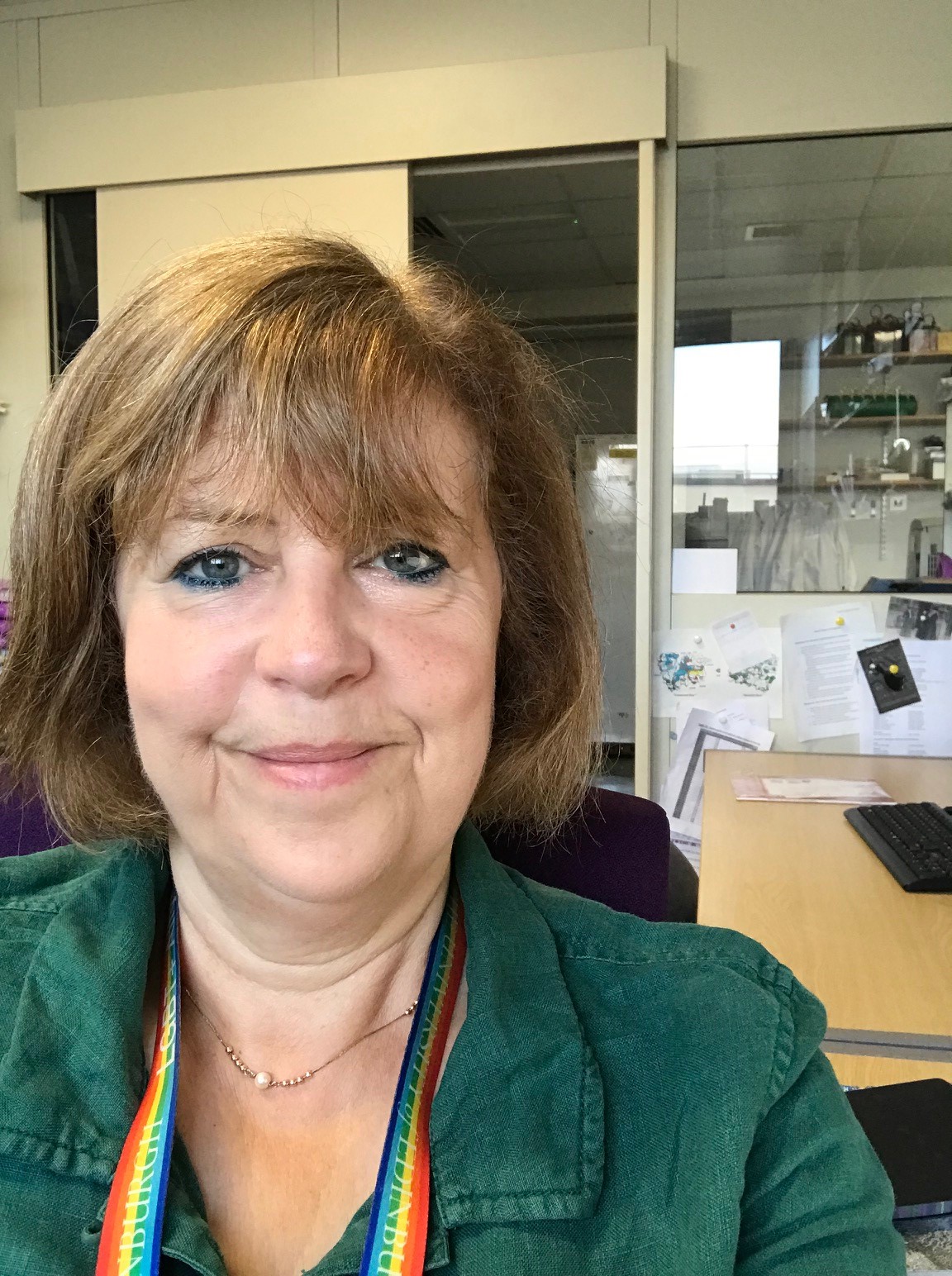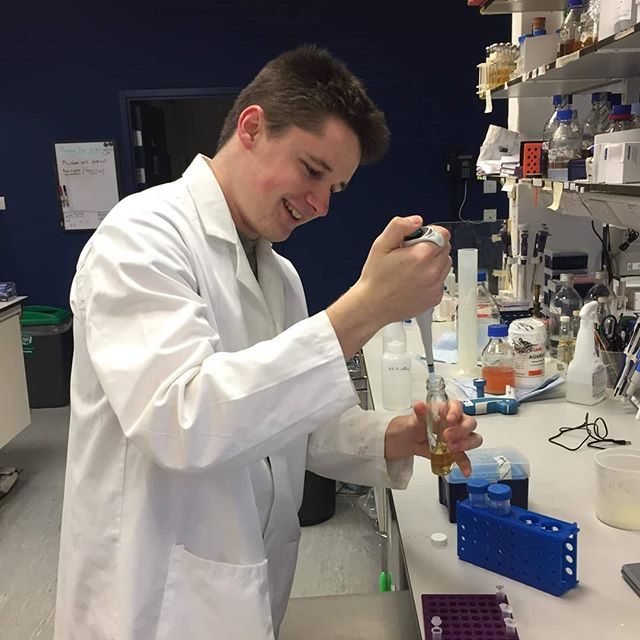
Hello- I’m Cathy and you can read more about me by clicking on the link above. I’ve been working on eEF1A2 for a *very* long time and both the science and the contact with families affected by mutations in the gene are subjects very close to my heart.
Grant Marshall

Hey – I’m Grant and I’m a postdoctoral researcher in Cathy’s lab! My eEF1A2-related research focusses on mice which we have engineered to carry a common and severe eEF1A2 missense mutation. I am studying whether these mice experience spontaneous seizures and whether they have increased seizure susceptibility in order to establish whether they are a useful model of the human disorder that could be used to develop treatments. I’m also interested in figuring out why completely different mutations in eEF1A2 can all lead to similar neurodevelopmental disorders. To do this I am investigating the basic biology of eEF1A proteins, particularly where and when they are expressed in neurons.
Cavan Bennett-Ness

Hello! I’m Cavan, and I’m a PhD student in Cathy’s lab. I’m going to be looking at eEF1A2’s main job, building all of the proteins in nerve and muscle cells, and how this is affected by the mutations.
I’ll do this by modelling the eEF1A2 mutations in human cells, and then looking at their ability to make new proteins. I want to see if the mutations disrupt eEF1A2 from making new proteins, or even cause it to make faulty, toxic proteins. Working out precisely what these mutations do to eEF1A2 is a key step in understanding how they cause epilepsy, intellectual disability and autism.
Heather Love

I’m Heather, a PhD student in Cathy’s lab. As there are so many different harmful mutations in eEF1A2, I’m trying to find out if there are any differences or similarities between the mutations that we can use to group them. We hope that by grouping the mutations, we can understand the effects of different mutations on eEF1A2, target our research more efficiently, and potentially learn more about how singly occurring mutations might progress. I have looked at how some mutations affect the stability of eEF1A2 (how long it lasts in the cell), and how they affect the way that eEF1A2 binds to other proteins.
Tamsin Baxter

Hello, I’m Tamsin a PhD student in Cathy’s lab. I will be looking at whether we can use drugs that are already used to treat other medical conditions to increase the levels of normal eEF1A2 or decrease the levels of mutant eEF1A2. To do this I will be using specialised neuronal cell lines to look at the amount of eEF1A2 in cells after they have been treated with different drugs and also developing ways to screen lots of different drugs at once using a high-throughput assay. By the end of my project, I hope to have tested some drugs in our mouse models which mimic some of the mutations that are seen in human patients, looking to see if we can reduce seizure incidence or improve other symptoms of disease with drugs in an animal model.
Jamey Brewster

Hey! I’m Jamey, a PhD student in the Abbott lab. My work will focus on understanding precisely where eEF1A2 and its sister protein, eEF1A1, are located in neurons. For a long time we thought that eEF1A1 was completely ‘switched off’ in the brain when eEF1A2 got turned on, but Cathy’s lab have recently found that eEF1A1 is actually in neurons at the same time as eEF1A2. Different parts of each neuron are important for different aspects of brain development, so knowing which parts eEF1A1 and eEF1A2 move towards will give us clues about each of their functions.
Some recent studies have found that eEF1A2 can do more than just help cells to make proteins; for example, it seems to be involved in remodelling the shape of neurons, which is really important for making sure that they can communicate with each other properly. But we don’t know much at all about the roles of eEF1A1, or why it’s needed in neurons as well as eEF1A2. Later on in my project, I will try to swap where eEF1A1 and eEF1A2 localise in neurons, to work out whether they are important for the same or different aspects of brain development. If eEF1A1 can do the same jobs as eEF1A2 in neurons, we will see if replacing faulty eEF1A2 in mice with their healthy copy of eEF1A1 can reduce their seizures and movement difficulties. My project is a collaboration with Paul Donlin-Asp https://www.donlin-asp-lab.com/
Nika Balkic

Hello! I’m Nika, a PhD student in Cathy’s lab. I hope to contribute to solving the challenge of finding epilepsy treatments that don’t lead to drug resistance. To do so, these treatments should ideally be tested in animal models that closely resemble human epilepsy. While there are mouse models with the same genetic mechanisms as human patients, these mice often don’t show signs of spontaneous seizures. My project is focused on identifying behaviours or biomarkers that can serve as indicators of epilepsy in these mice. This will help us better understand epilepsy and make it easier to translate research findings into better treatments.
Past lab members
Dr Faith Davies

I’m Faith and I’ve worked in Cathy’s lab since 2011, first as a PhD student and now as a post-doctoral researcher. From the start of my time here I’ve been working on different projects that all attempt to increase our understanding of eEF1A2 protein.
I generated a mouse that carries one of the eEF1A2 mutations we’ve seen in human patients and have studied it extensively over the past few years to discover more about how the mutation changes the function of eEF1A2, and to assess the mouse’s suitability for use in trials of any potential future therapeutics.
I recently engineered a type of mouse with a small tag on the end of the eEF1A2 protein that allows us to see where exactly it is expressed in the brain. This will give us more information about the the importance of eEF1A2 in different brain processes. I’m also interested in the way that mutations change how eEF1A2 interacts with other proteins in the cell, and how these changes may lead to neurodevelopmental disorders.
Josie Macdonald

Hi! I’m Josie, a visiting worker in the Abbott lab, and my main interest is in seeing how some of eEF1A2’s clinical mutations affects the structure of eEF1A2 and the proteins it interacts with. I’m doing this through computational modelling of the eEF1A2 mutations, which shows us a computer-generated proposition of structural changes to eEF1A2 caused by each mutation and how this might strengthen or weaken eEF1A2’s binding to its protein partners. Using my data from the computer modelling, I then design experiments to see if the mutated versions of eEF1A2 give the same results in living cells as in the model. This work will tell us how each eEF1A2 clinical mutation affects its ability to function and interact as the normal protein would, and provide clues into understanding at a molecular level why mutated eEF1A2 can cause epilepsy, intellectual disability and autism.
Danni Gadd

Hello. I’m Danni and I’m a PhD student spending 3 months working with the Abbott lab this year. I’m on a translational neuroscience programme, which means that I’m focused on understanding how we can design research that can translate from the lab through to developing treatments for humans. I am interested generally in the way that our brain cells form connections called synapses and how these connections are changed and can give rise to symptoms such as seizures.
During my time in the Abbott lab I’m going to be mapping the expression of eEF1A2 in the mouse brain, by using a fluorescent tag that attaches to the protein in the brain so that we can see it. This work will help us understand more about the areas of the brain that eEF1A2 is present in and whether there are specific cells that have more or less of it. It will give us important clues about the possible ways that the mutations affecting eEF1A2 could change the behaviour of cells in the brain, which will lead us closer to understanding how a mutation in the gene producing eEF1A2 gives rise to the range of symptoms people experience.